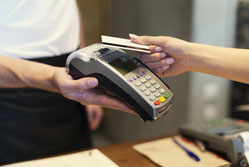Do you understand contactless payments?
Do you understand contactless payments?
 The ways we pay are changing fast. No matter what sort of business you run, customers will expect to be able to pay by their preferred method.
The ways we pay are changing fast. No matter what sort of business you run, customers will expect to be able to pay by their preferred method.
If you only accept a limited number of payment methods, people may be put off buying from you. With that in mind, perhaps you should be thinking about contactless payment, because this is one option that has really taken off in the last 12 months.
Contactless growth
Contactless payments are growing fast. Monthly spending on contactless cards exceeded £100m for the first time in March 2014, according to the UK Cards Association.
More than 370 contactless transactions are made every minute in the UK. That’s six per second — three times more than a year ago.
Although contactless is seen as a new technology, it’s actually been around since 2008. The same technology powers Transport for London’s Oyster card system, where passengers pay for public transport journeys via contactless cards pre-loaded with credit.
How contactless works
Contactless cards use a short-range wireless system called near field communications (NFC).
Contactless debit and credit cards are fitted with an antenna that connects them with devices up to 5cm away. When the cardholder passes their card close to a contactless payment machine, their payment is registered.
Because it’s so easy to make a payment, the contactless system has been designed to minimise the chance of duplicate or accidental transactions.
The terminals make sure only one payment is taken per transaction. To make a second payment, the card has to be taken out of range of the card reader, and then reintroduced.
Even then, a second payment will only be taken if the sales assistant has initiated a new transaction.
Software in the cash register or point of sale terminal also checks if there’s more than one card within range. It will reject the transaction if there’s a risk of the wrong card being charged.
The contactless advantage
‘Tap and go’ contactless transactions take less than a second, making shopping quicker and easier. If you run a shop, this reduces queues, makes customers happier and gives you more time to engage with them.
Major high street names such as Marks & Spencer, Costa and Boots are all using contactless. Although uptake among smaller businesses is harder to measure, it seems widespread.
There’ll already be at least one business on your local High Street that accepts contactless payments. More are joining every day.
This post is by Andy Macauley, chief operating officer at Handepay, which offers a free guide to contactless payments.




Comments
Add a comment